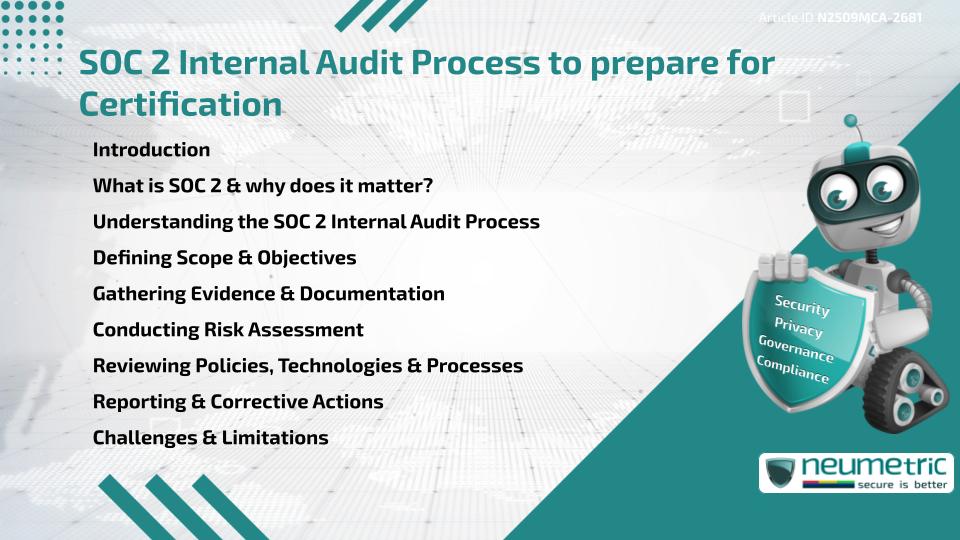Table of Contents
ToggleIntroduction
The SOC 2 Internal Audit process is a vital step for organisations seeking SOC 2 Certification. It evaluates whether existing Security Controls align with the Trust Service Criteria, such as Security, Availability, Processing Integrity, Confidentiality & Privacy. By following this structured approach, companies can identify Gaps, strengthen Data Security & demonstrate commitment to Customer Trust. This article explains the key stages of the Audit process, its importance, common challenges & practical strategies for success.
What is SOC 2 & why does it matter?
SOC 2 Certification is a widely recognised Standard designed for Service Organisations. It assures Clients & Partners that a company handles Customer Information securely. Unlike ISO 27001 Certification, which is broader, SOC 2 focuses specifically on systems managing Sensitive Customer Information. For SaaS Providers & Cloud Service Providers, SOC 2 plays a critical role in building Trust & meeting Compliance Requirements.
Understanding the SOC 2 Internal Audit Process
The SOC 2 Internal Audit process helps organisations evaluate readiness before engaging a Licensed CPA Firm for a formal SOC 2 Audit. It identifies strengths, weaknesses & areas for Corrective Actions. This self-Assessment functions as a rehearsal, ensuring organisations are well-prepared for the official Audit Engagement.
Defining Scope & Objectives
The first step is Defining Scope. Organisations must clarify which Systems & Data fall under review. Setting clear Objectives ensures the Audit is focused on Business Objectives & Customer Expectations. Without a defined scope, Audits can become inefficient & fail to provide meaningful results.
Gathering Evidence & Documentation
During this stage, organisations collect Evidence such as Access Logs, Security Policies & Incident Response Plans. Documentation ensures Auditors can verify Compliance with the Trust Service Criteria. It also helps in demonstrating that Security Controls are not only defined but also operational & effective.
Conducting Risk Assessment
A Risk Assessment identifies Assets, Risks & Vulnerabilities that may affect Compliance. Organisations evaluate the Likelihood & Impact of each Risk, prioritising areas that need immediate attention. This step ensures that resources are used efficiently to address the most critical Threats.
Reviewing Policies, Technologies & Processes
The Audit also examines whether Policies, Technologies & Processes are effectively implemented. For example, Access Controls, Encryption & Security Monitoring Tools are checked to confirm alignment with Regulatory Standards. This stage highlights whether ongoing Continuous Monitoring & Improvement is taking place.
Reporting & Corrective Actions
After evaluation, findings are documented in a detailed report. The report outlines Audit Findings, Strengths, Weaknesses & necessary Corrective Actions. Addressing these Gaps before the formal SOC 2 Audit increases the chances of achieving SOC 2 Certification without major Non-Conformities.
Challenges & Limitations
The SOC 2 Internal Audit process is not without its challenges. Organisations often face Resource Constraints, Complex Documentation requirements & evolving Cybersecurity Threats. Additionally, internal teams may lack the independence of External Auditors, which can introduce bias. Despite these limitations, Internal Audits remain a crucial step in ensuring readiness.
Takeaways
- Strengthens Compliance with Trust Service Criteria
- Identifies weaknesses & provides Corrective Actions
- Enhances trust with Clients & Partners
- Encourages Continuous Monitoring & Improvement
- Increases readiness for successful SOC 2 Certification
FAQ
What is the purpose of the SOC 2 Internal Audit process?
It helps organisations evaluate their readiness for SOC 2 Certification by identifying strengths, weaknesses & areas for improvement.
How long does the SOC 2 Internal Audit process take?
It depends on scope & complexity but typically ranges from a few weeks to several months.
Is a SOC 2 Internal Audit process mandatory?
No, it is not mandatory but strongly recommended to avoid failures in the formal SOC 2 Audit.
Who should conduct the SOC 2 Internal Audit process?
Internal teams with security expertise or Third Party consultants with SOC 2 experience should conduct it.
How often should a SOC 2 Internal Audit process be performed?
It is best to perform the Audit annually or whenever there are significant changes to Systems, Processes or Controls.
What are common mistakes in the SOC 2 Internal Audit process?
Failing to define scope, incomplete documentation & ignoring Risk Assessments are common mistakes.
Can smaller organisations benefit from the SOC 2 Internal Audit process?
Yes, Small Businesses can strengthen Data Security & build Trust with Clients & Partners by following this process.
Need help for Security, Privacy, Governance & VAPT?
Neumetric provides organisations the necessary help to achieve their Cybersecurity, Compliance, Governance, Privacy, Certifications & Pentesting needs.
Organisations & Businesses, specifically those which provide SaaS & AI Solutions in the Fintech, BFSI & other regulated sectors, usually need a Cybersecurity Partner for meeting & maintaining the ongoing Security & Privacy needs & requirements of their Enterprise Clients & Privacy conscious Customers.
SOC 2, ISO 27001, ISO 42001, NIST, HIPAA, HECVAT, EU GDPR are some of the Frameworks that are served by Fusion – a SaaS, multimodular, multitenant, centralised, automated, Cybersecurity & Compliance Management system.
Neumetric also provides Expert Services for technical security which covers VAPT for Web Applications, APIs, iOS & Android Mobile Apps, Security Testing for AWS & other Cloud Environments & Cloud Infrastructure & other similar scopes.
Reach out to us by Email or filling out the Contact Form…


